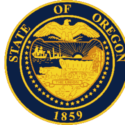The border between Canada and Oregon was settled in 1846, when the U.S. and Britain signed the Oregon Territory. Over the next ten years, the people of Oregon voted against statehood three times. Finally, in 1857, the citizens of Oregon voted for statehood. They created a convention, elected representatives and a governor, and put the Tennessee Plan into action.
They still had a Washington-appointed territorial governor. For two years, Oregon had a state government and a territorial government, but on Valentine’s Day, 1859, they finally were admitted as a state.
What was going on during the 11 years between settling the border and admitting Oregon as a state?
Three political parties
Oregon had three popular political parties. People living there called their home “Oregon Country,” even though it was actually the Oregon Territory, a U.S. territory belonging to the United States. Many of the people in Oregon were upset that they didn’t have the sovereignty and control a state would have — they didn’t like the fact that Washington had so much power over their lives. Sounds like Puerto Rico, so far.
But Oregon had some other problems of its own. Congress had an admissions bill for Oregon, but the bill got stuck in the committee on territories. Some simply thought the population of Oregon was too small. Representatives from states where slavery was legal didn’t want to see another “free” state enter the Union. At the same time, Oregon’s constitution included a high level of racial discrimination, and many members of Congress objected to those attitudes.
After six months of debate in the committee, the bill went to the floor for a vote. The same issues — population and civil rights — came up again.
The Republicans in Congress had decided not to allow Oregon to join the Union. Most of the delegates from Oregon were Democrats; just as we now hear that a Republican Congress won’t allow Puerto Rico to become a state, Congress in 1859 might have worried about Democratic delegates. When the issue came to a final vote, though, a number of Republicans changed their minds. They surprised everyone by voting to admit Oregon. The vote was very close: 114 to 103.
A close vote doesn’t make a difference, though. In the United States, a small majority is still a majority. The bill won, the president signed it, and Oregon became a state two days later. It took another month for that news to reach the Governor of Oregon.
Lessons for Puerto Rico
Congress has already approved Puerto Rico’s constitution and the population is certainly large enough for statehood. These problems, which made it hard for Oregon to be admitted, aren’t issues for Puerto Rico.
But Puerto Rico, like Oregon, is facing delays caused by national political issues. In spite of Puerto Rico’s bipartisan delegation and evidence that Puerto Rico might be either a red or a blue state, there are plenty of people who believe that Republicans in Congress will not accept Puerto Rico.
Oregon’s request for admission started with these facts: “Whereas the people of Oregon have framed, ratified, and adopted a constitution of State government which is republican in form, and in conformity with the Constitution of the United States, and have applied for admission into the Union on an equal footing with the other States…”
It took some time for Oregon to be admitted as a state, but they held firm and were admitted. Puerto Rico can do the same. Join us, and share the news with others. There’s no going back, so we must go forward.








No responses yet